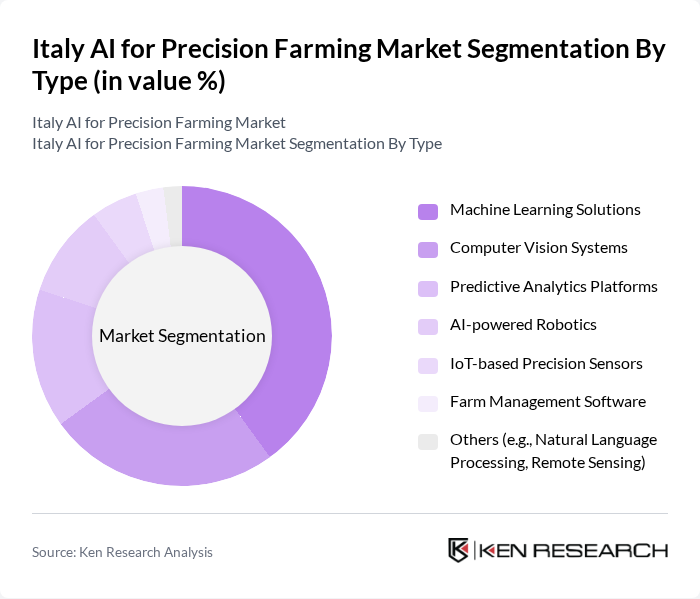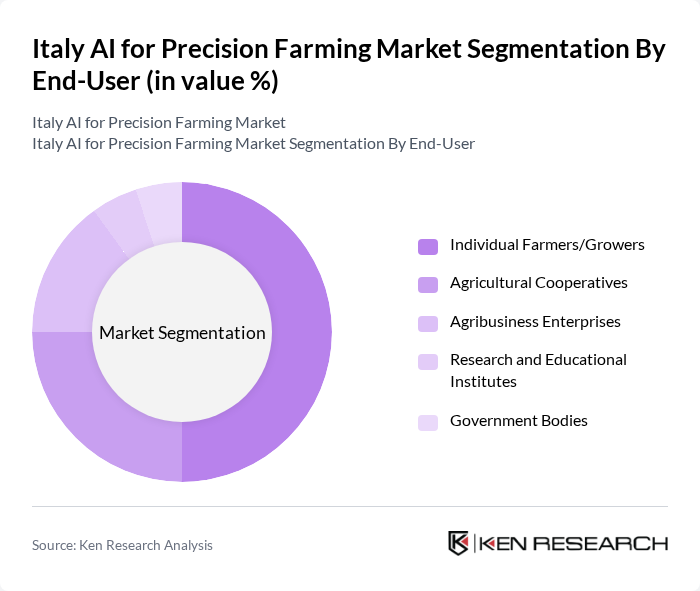Region:Europe
Author(s):Geetanshi
Product Code:KRAA3660
Pages:93
Published On:September 2025

By Type:The market is segmented into various types of AI solutions that cater to precision farming needs. The dominant sub-segment is Machine Learning Solutions, which are widely adopted for their ability to analyze large datasets and provide actionable insights. Other notable segments include Computer Vision Systems and IoT-based Precision Sensors, which are gaining traction due to their effectiveness in monitoring crop health and optimizing resource usage. The software segment, including farm management platforms and predictive analytics, is rapidly expanding due to its scalability and integration with existing farm equipment .

By End-User:The end-user segment includes various stakeholders in the agricultural sector. Individual Farmers/Growers represent the largest share, driven by the increasing need for efficient farming practices. Agricultural Cooperatives and Agribusiness Enterprises also play significant roles, as they seek to enhance productivity and reduce costs through advanced technologies. Research and educational institutes, as well as government bodies, are increasingly adopting AI-driven solutions for pilot projects and policy implementation .

The Italy AI for Precision Farming Market is characterized by a dynamic mix of regional and international players. Leading participants such as Trimble Inc., AG Leader Technology, Raven Industries, John Deere, Bayer Crop Science, BASF SE, CNH Industrial N.V., The Climate Corporation, Taranis, Farmers Edge, PrecisionHawk, CropX, xFarm Technologies S.p.A., Agricolus S.r.l., Syngenta Group contribute to innovation, geographic expansion, and service delivery in this space.
The future of the Italy AI for Precision Farming market appears promising, driven by technological advancements and increasing government support. In future, the integration of AI and IoT technologies is expected to enhance operational efficiency, with farmers utilizing data-driven insights for better decision-making. As sustainability becomes a priority, the demand for innovative solutions will likely rise, fostering collaborations between agricultural stakeholders and tech companies to develop cutting-edge tools that address emerging challenges in the sector.
| Segment | Sub-Segments |
|---|---|
| By Type | Machine Learning Solutions Computer Vision Systems Predictive Analytics Platforms AI-powered Robotics IoT-based Precision Sensors Farm Management Software Others (e.g., Natural Language Processing, Remote Sensing) |
| By End-User | Individual Farmers/Growers Agricultural Cooperatives Agribusiness Enterprises Research and Educational Institutes Government Bodies |
| By Application | Crop Health Monitoring Soil Health Monitoring Disease and Pest Detection Irrigation Optimization Yield Prediction Climate and Weather Forecasting Livestock Monitoring |
| By Distribution Channel | Direct Sales Online Platforms Distributors and Resellers |
| By Technology | Machine Learning Computer Vision IoT Solutions Robotics Predictive Analytics |
| By Investment Source | Private Investments Government Grants Venture Capital |
| By Policy Support | Subsidies for AI Adoption Tax Incentives for Sustainable Practices Research and Development Grants |
| Scope Item/Segment | Sample Size | Target Respondent Profiles |
|---|---|---|
| AI Adoption in Crop Management | 120 | Farm Owners, Agronomists |
| Precision Farming Technologies | 90 | Technology Developers, Agricultural Consultants |
| Data Analytics in Agriculture | 60 | Data Scientists, Farm Managers |
| Impact of AI on Yield Improvement | 50 | Research Scientists, Agricultural Economists |
| Government Policies on Agricultural Innovation | 40 | Policy Makers, Regulatory Affairs Specialists |
The Italy AI for Precision Farming Market is valued at approximately USD 820 million, reflecting a significant growth trend driven by the adoption of advanced technologies like machine learning and IoT, which enhance agricultural productivity and efficiency.